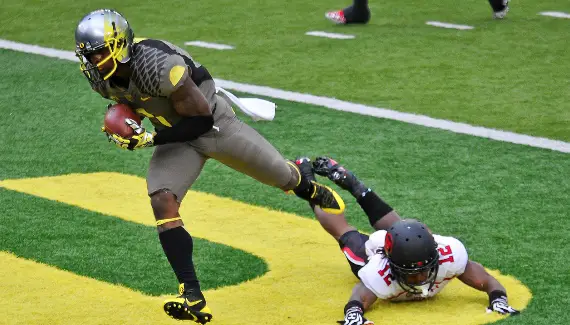With Eagles’ camp opening last Friday, it’s a great time to talk Oregon Spread Offense here in Philadelphia. The success of the Eagles in 2013 excited both the fan base and the local sports media. The extensive coverage of the Eagles, especially their offensive scheme, has brought a new understanding and appreciation in this region for the Oregon offense.
I have been fortunate over the past few months to develop a friendship with one of the bests analysts of Eagles football: Sheil Kapadia. Sheil is an Eagles beat reporter who does an outstanding job explaining both the philosophy and scheme of the Eagles’ offense.
About a month ago, Sheil and I were discussing the Eagles’ Red Zone offense and their favorite pass plays in that area. Our conversation and the excellent article that followed, Double Posts in the Red Zone, centered around a classic Oregon pass play: the Double Post. This article will analyze two different Double Post calls vs Utah last season. Much like their former head coach, Oregon combined a little play-action with a lot of execution to finish drives with PATs rather than field goals.
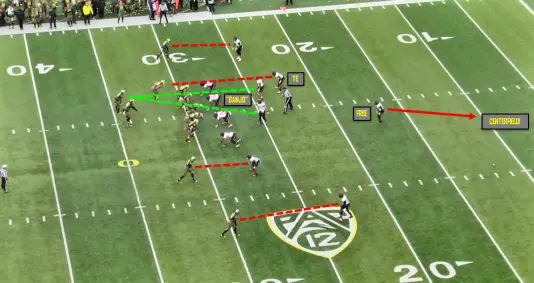
On this play in the 3rd quarter, Utah lines up with one deep safety and shows a man-coverage-with-help look. This is a common call against spread offenses because man coverage with deep free safety help allows the defense to get seven defenders in the box. This extra defender in the middle is a sound move to combat the highly productive Oregon run game.
Man coverage also allows the Utes to “cover down” all of Oregon’s receivers. By “covering down” the formation (lining a defender up directly over each/every receiver), the Utes are trying to eliminate the Ducks’ bubble/quick screen game.
Underneath are the two inside linebackers who will “banjo” the running back (GREEN DOTTED LINES). A “banjo” call puts the linebacker to the side that the back releases in man coverage with the RB. The other inside linebacker (away from the back’s release) will become a “hole” or free player underneath.
This man-with-help coverage, locks the Ute defensive backs on the Oregon receivers with a single deep safety in centerfield. The free safety’s job in this coverage is to be the deepest player in the middle of the field at all times. He must forgo stopping the run to protect against the deep pass.
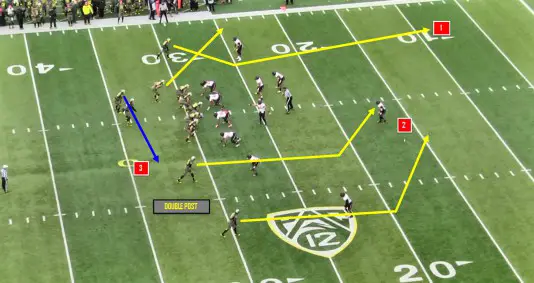
The Ducks are running a classic red zone call on this play — the Double Post. The boundary receiver will run an inside “stem” (pass route) vertical designed to take a shot down the field (RED BOX No. 1). If this vertical route is covered, then Marcus Mariota will progress to his next read, which is the Double Post combination to the field (RED BOX No. 2).
Mariota will next look at the free safety. If the safety takes away the inside post, then Mariota knows he will have single coverage on the outside. If the corner covers the outside post, he will check the ball down to the back (BLUE ARROW) — who is faking the inside zone and running a swing route to the field, or wide side.

Mariota begins his progression exactly as he is taught: by checking the vertical route into the boundary (GREEN ARROWS). This initial read/eye movement by the quarterback moves the free safety away from the middle of the field. The slot receiver running the inside post also puts the free safety in conflict. The slot will angle his route towards the inside shoulder of the free safety. This path forces the safety to choose between playing his deep responsibilities or helping his teammate cover the inside post.
Josh Huff (bottom receiver on the screen) does an excellent job breaking down the “cushion” (space) of the man covering him. Huff’s fast vertical stem directly at the defensive back challenges his defender. The fast/deep threat of a vertical receiver down the field forces the corner to turn and run. This reaction — created by Huff’s explosive vertical stem — locks the corner’s hips away from the post. Huff has created leverage on the inside by having a plan for his route and executing it at great speed.

Mariota’s eye manipulation and the slot recevier’s route do their job. The free safety is no longer the deepest player on the field — that designation now belongs to Huff. Mariota — recognizing the position of the free safety and Huff breaking down the cushion of his defender — throws the deep ball. The corner is forced to tackle Huff before the ball arrives to prevent a touchdown (interference was called).
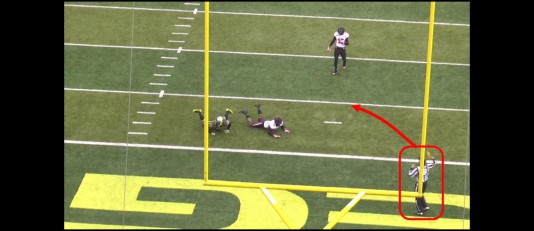

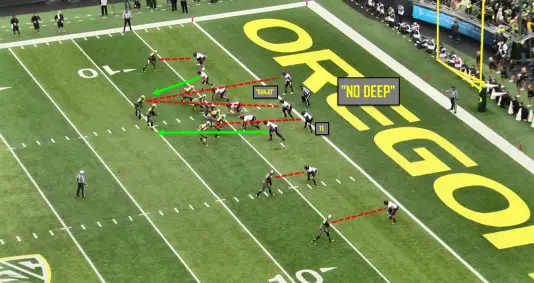
Earlier in the same game, Utah lines up in a look that is even more aggressive. The Utes bring two outside blitzers (GREEN ARROWS) and play man coverage with no deep help. This Cover Zero look (with only 5 rushers instead of 6) also has two inside defenders ‘banjoing” the single back.
On the perimeter, the defensive backs line up inside their receiver. This alignment is designed to stop any inside breaking route with pre-snap leverage and force a lower percentage outside throw. The call by the Utes is designed to speed up the quarterback with pressure and disrupt the space and timing of the wide receivers.
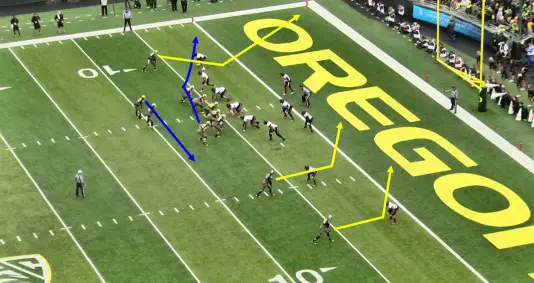
The Ducks are running the Double Post from a 3×1 formation with a play-action wrinkle. Both the tight end and running back show a “split flow” inside zone action (BLUE ARROWS). The tight end works across the formation, the same way he would when he blocks the backside end on a split flow inside zone.
When the ball is snapped, the routes are identical to the previous play we analyzed: two posts to the field and a vertical/flat to the boundary. The only adjustment is to the depth of the routes — Because the play starts so deep in the red zone, the depths will be shortened so they can happen quicker and make the most of the limited space.
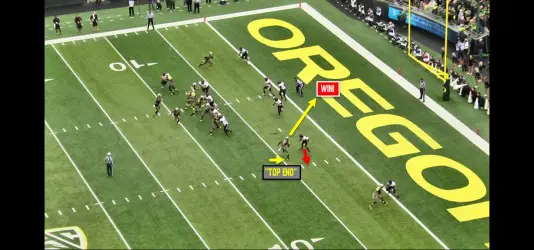
Huff, this time lined up in the slot, wins inside in a similar fashion to the previous Double Post. Even though the man assigned to cover him lines up with inside leverage, Huff stills finds a way to get in for the TD. His speed and sudden move at the top of the route creates the space that he needs. By slamming his outside foot in the ground at the top end/depth of the post, Huff locks his defender’s hips away from where he is going.
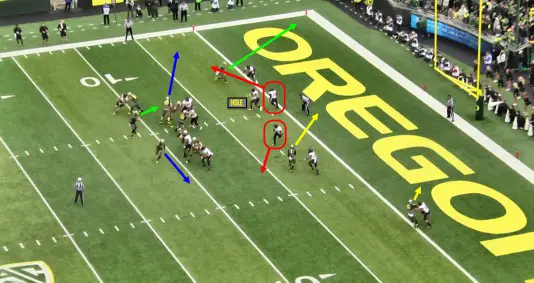
Once again, Mariota starts his read into the boundary (GREEN ARROWS). He uses his eyes to move the hole player out of the middle of the field. With a Cover Zero/no-deep look, the area in between the hashes is exactly where Mariota wants to go with the ball. With no one in centerfield, this is the easiest/best throw against this type of pressure. While the defenders assigned to the tight end and the back run to their man (RED BOXES/ARROWS), the hole player follows the quarterback’s eyes and vacates the middle.

The end zone view of this play shows how execution (pass protection, quarterback vision, route running) and scheme (play action, quarterback progression) combine to create a touchdown. Mariota knows the only player left to get underneath the inside post is the hole defender. By working quickly through his progression, instead of abandoning it in the face of the blitz, Mariota clears the passing lane with his eyes and then delivers the ball.
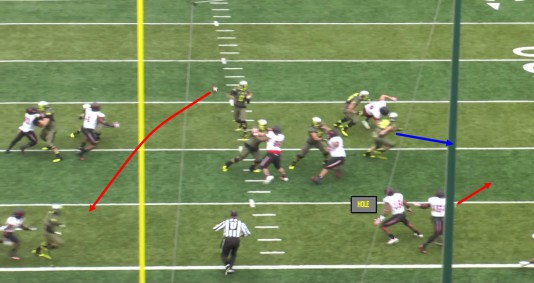
The Double Post ends up with exactly as it wanted versus no-deep pressure: Huff matched up one-on-one in the center of the field.

For me, a big part of the excitement of the upcoming season is the ever blurring lines between high school, college and professional offenses. Great offensive ideas are found everywhere — moving from high school/college to the pros at an ever increasing rate. Nowhere is this flow of ideas more evident than when I watch film of the Ducks and Eagles.
It’s a lot more fun to talk Philadelphia pro football today because I can see the influence of the Oregon offense at the game’s highest level. I am fired up to see what’s next for the Ducks passing offense in 2014 … and to see the Eagles’ “college offense” continue to tear it up on Sundays.
I may be in Philadelphia….”but oh how we love to learn about your beloved Ducks!”
Brian Flinn
Receivers Coach
Villanova University
Twitter: @Coach_Flinn
Top Photo by Kevin Cline
Coach Brian Flinn (Football Analyst) is entering his seventh year as Villanova University’s Wide Receivers Coach and Recruiting Coordinator. A native of Youngstown, OH, Brian Flinn was an All-OAC tight end at Mount Union College before entering the coaching ranks. In addition to Villanova, Coach Flinn has coached at Eastern Illinois University, Drake University, Maryland University, and Mount Union.
Go Villanova Wildcats!

